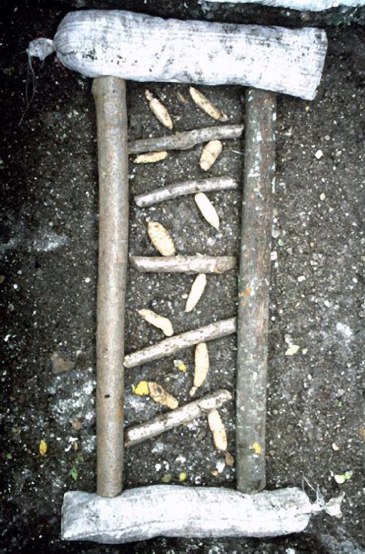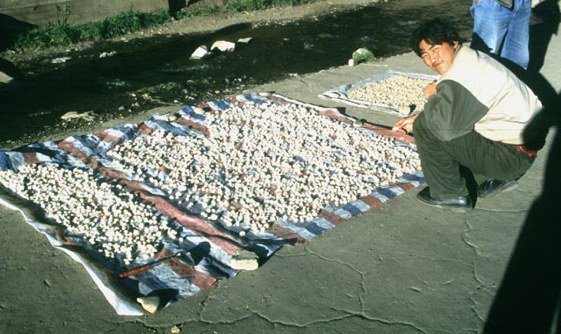 The beautiful and strange inflorescence of Noble Rhubarb (Rheum nobile). The actual flowers are all hidden under big whitish translucent bracts that genrate a glasshouse effect, protecting the flowers from wind, cold and UV-light, a challenge in its high altitude range.
In Tibetan Medicine it is known as Chhu/ Chu ma tsi or Chum kar according to Dr. Tenzin Dakpa (2007). It is used to treat edema / oedema of internal organs. It also lowers fever of bile and cures diseases arising from cold phlegm (two diagnoses based on the theory of Tibetan medicine).
© Daniel Winkler, Aug. 7, 2011, 4700m / 14500 ft, Nyingchi County, Nyingchi / Linzhi Prefecture, Tibet AR.
|
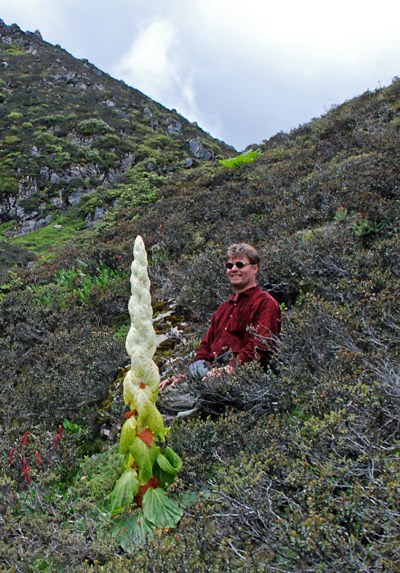 Noble Rhubarb is also sometimes known as Sikkim or Himalayan Rhubarb, the latter for example to be found on a postal stamp from Nepal. However, another rhubarb, Rheum emodi, has the "Himalayan" in its name, since "Emodi" is Latin for the Himalayas. I do not like the name Sikkim Rhubarb, because it is distributed in all alpine areas of the Himalayas from Afghanistan to Arunachal Pradesh [Easternmost Himalayas, just North of Assam], as well as Tibet and Burma.
|
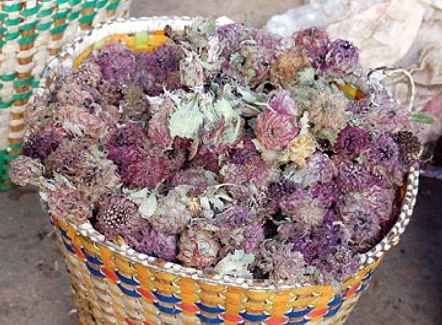 Saussurea medusa (Asteraceae) is known to Tibetan herb collectors as Ganglha Metok [gangs lha me tog], meaning glacier or snow deity flower. It is an important medicinal in Rigpa Sowa (Tibetan Medicine) andTraditional Chinese Medicine. In TCM it is known as "xue lian", meaning snow lotus. It grows way high up in the mountains, up to 5200m, and overcollection is of great concern.
© Daniel Winkler, August 2, 2007, 4100m, Litang County, Ganzi TAP, W-Sichuan.
|
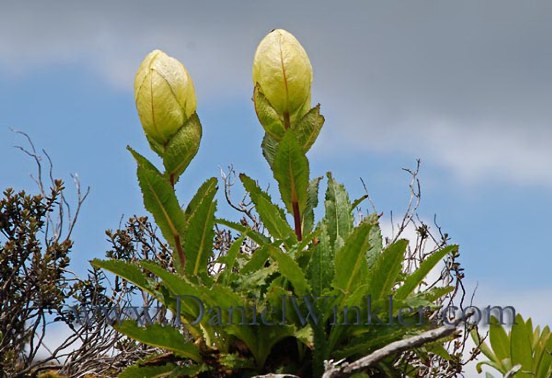 Saussurea obvallata (Asteraceae) is another plant with the same high altitude adaptation as Rheum nobile, but not related. It is a medicinal in Tibetan medicine known as Zadue Gogu. It is used to treat epilepsy, healing sores and relieving serious pain (Tenzin Dakpa 2007, Tibetan Medicinal Plants, New Delhi).
|
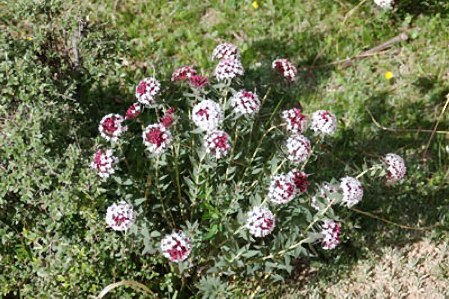 Stellera chamaejasme, a herbaceous relative of Daphne (Thymeleaceae), and also very fragrant, has traditionally been used to make paper in Tibet. It is also used in veterinary medicine to purge livestock from worms and other intestinal parasites. Stellera chamaejasme is known as "Re-lCag-Pa" in Tibetan medicine and in Chinese as Langqing. © Daniel Winkler, June 19, 2006, 4300m, above Tashigang - Ri Chu Valley, Meldrogongkar County, Lhasa, Tibet AR
|
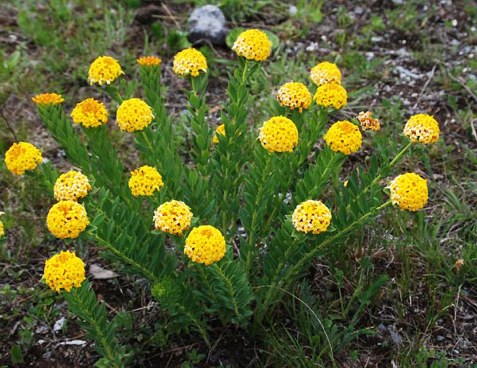 A yellow flowering Stellera chamaejasme. Stellera flower yellow and white, but the calyx can be yellow, white, pink, reddish or purple, resulting in a variety in colors visible before the flower opens (on left a white flower with red calyx).
|
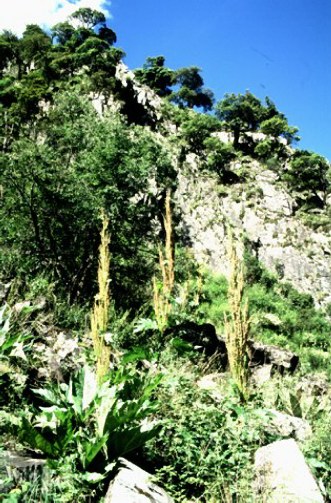 Wild Rheum growing on a sunny slope, © Daniel Winkler, August 2001, 3400m, Litang County, Ganzi TAP, W-Sichuan
|
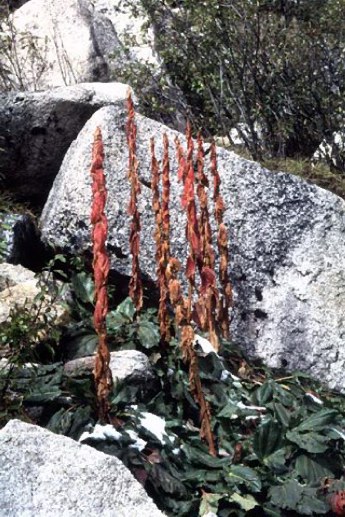 Rheum alexandrae, © Daniel Winkler, August 2001, 4200m, Litang County, Ganzi TAP, W-Sichuan
|
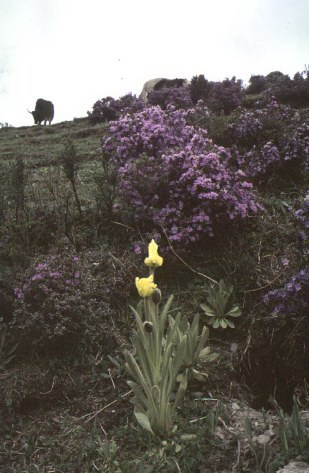 |
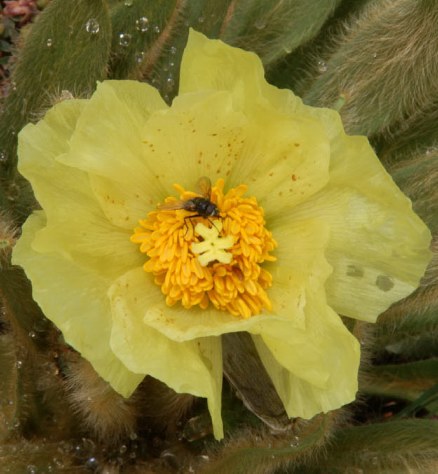 |
|
Meconopsis integrifolia (Papaveraceae) below a Rhododendron from the 'nivale' group. Meconopsis, Himalayan poppy, is one of Tibet's most famous flowers and used as medicinal plant. © Daniel Winkler June 1999, 4300m, Litang County, Ganzi TAP, W-Sichuan
|
Meconopsis integrifolia, a truly high alpine Himalayan poppy. The hirsute (=hairy) nature of its leaves is an adaptation to the cold high altitude climate it thrives in. I have encountered this Himalayan poppy several times standing out in freshly snow-covered slopes.
© Daniel Winkler, Kongpo Barla, Medro-Gongkar, Lhasa Prefecture, Tibet AR, June 2006
|
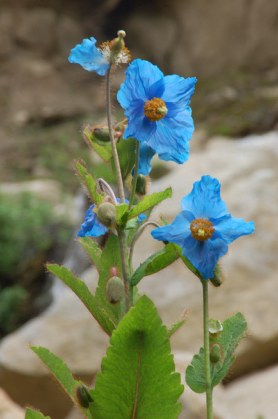 Meconopsis baileyi, the archetype of Himalayan blue poppy.
© Daniel Winkler, Serkyim La, Nyingchi County, Nyingchi Prefecture, Tibet AR, June 2006
|
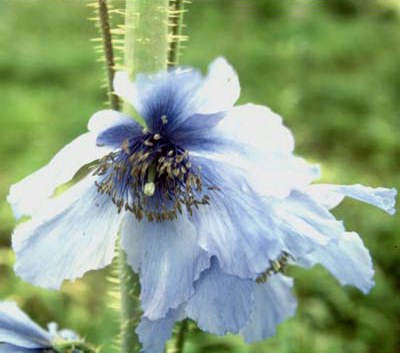 Close-up of Meconopsis aff. horridula, known in Tibetan Medicine as 'Utpala' . This one was found in Gyalthang County, in Pinyin formerly known as Zhongdian and currently known as Shangrila, Xianggerila, Dechen/Deqen TAP, NW-Yunnan. © Daniel Winkler, July 27, 2001
|
|
Planting bed for the orchid Gastrodia elata, which is known in TCM as Tianma. Tubers of this orchid are planted between cut stems derived from deciduous trees. Along the sides of this lay-out wood chips in porous plastic bags are added. Tianma is a saprophytic perennial that does not carry out photosynthesis, but is fed by fungi, which live off decaying wood. One kilogram of Gastrodia tubers sold for around 360 Yuan ($45) within China and for $80-$90$ in Asia in 2002.
© Daniel Winkler, November 2001, Barkam County, Aba TAP, W-Sichuan
|
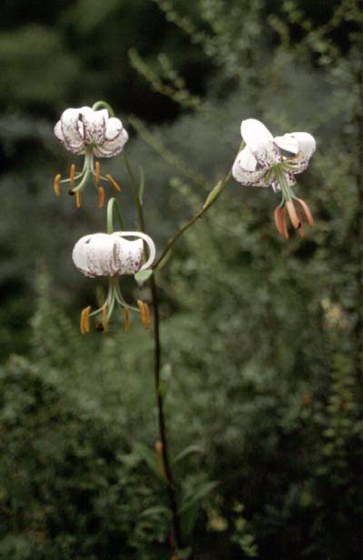 Coming across a lily in most Tibetan areas occurs much less frequent than one would expect. This can be explained by the fact that lily bulbs are used as remedies in TCM. Also, Tibetans and Chinese like to eat the bulbs. This lily is Lilium taliense. © Daniel Winkler, 2800m, Zitsa Degu / Jiuzhaigou, W-Sichuan, July 1991.
|
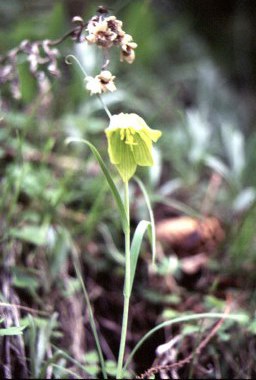 Fritillaria cirrhosa (Liliaceae) is one of Tibet's most important medicinal plants. It's pea-sized white bulbs (see below) are sold dried for export down to China. In Tibetan it is known as "Pema (Padma)" and in Chinese as "Chuan Beimu". Also, they are used as a specialty ingredient for Chinese yaojiu - medicinal schnapps. © Daniel Winkler June 1997, 4150m, Riwoqe County, Qamdo Prefecture, Tibet AR
|
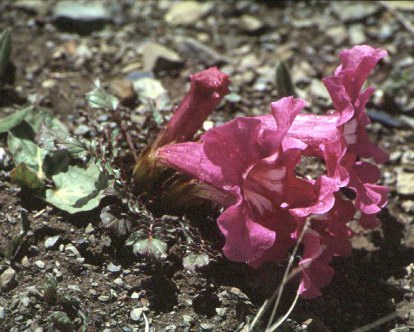 Incarvillea mairei (Begoniaceae). Incarvillea species are found all over the Tibetan Plateau. In central and western Tibet they send a stemless flower and a few leaves out over the windswept ground. In the Southeastern Plateau region some Incarvilleaspecies reach up to 1.5m, one of them the yellow flowering Incarvillea lutea.
© Daniel Winkler, June 1999, 4100m, Litang County, Ganzi TAP, W-Sichuan
|
|
Troma - Argentina anserina
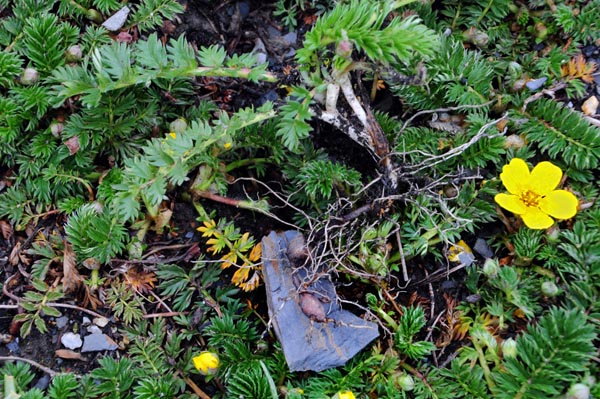 Troma (gro-mar) growing in a typical disturbed site. I dug out one of the plants to show the tuber and placed it on a piece of slate. © Daniel Winkler, May 30, 2012, 3900m, Dora Khamo, near Lhagang (Tagong), Kangding County, Ganzi TAP, Sichuan. Rockhill (1891) reports that `Choma' is also very popular in Mongolia, where it is known as `zuuna'. Rockhill continues "The Chinese call it `yao-miao-ken' or jen-shou-kuo [zhen shu guo?], fruit of respect and longevity, from its being sent to friends, with wishes for their welfare, by persons returning from the countries where it grows. In Kan-su the Chinese call it choma or chüem-ma. It is found in many parts of Chinese Turkestan [Xinjiang] but chiefly in eastern Tibet". Rockhill states also, that Tromar is the only vegetable eaten by Amdo nomads. A closely related plant, Potentilla pacifica also known as Argentina pacifica, which grows in coastal areas in the Pacific Northwest has been used as a vegetable by native American people (thanks to Steve Dupey for that information). |
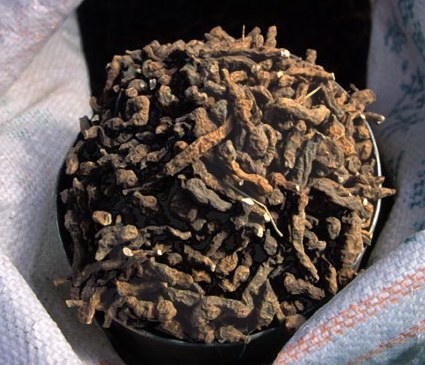 Dried Tromar sold at the market in Eastern Tibet.
© Daniel Winkler Litang, Kandze / Ganzi TAP,
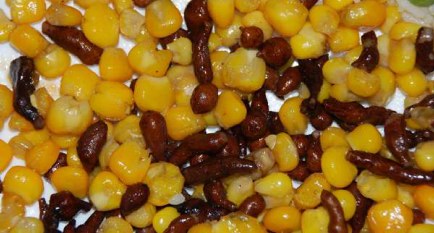 Steamed Droma served with corn or maize. This has become a popular preparation recently. Otherwise I was used to get droma prepared in melted butter with a bit of sugar, a preparation heavily dependend on the state of the butter, which sometimes is just too rancid for my taste.
© Daniel Winkler, Lhasa, July 2010.
|
|
Mick Rigdrol inspects freshly harvested Fritillaria (probably F. cirrhosa) bulbs. Digging Fritillaria is a very common source for generating a cash income in rural areas. Rigdrol put himself through school by digging Pema, as Tibetans know it.
© Daniel Winkler, August 14, 2001, Sertar County, Ganzi TAP, W-Sichuan
Fritillaria is used in Traditional Chinese and Traditional Tibetan Medicine. The demand for Fritillaria is driven by TCM, which knows it as "Bai mu".
Fritillaria is a good example of a NLGP, a non-livestock grassland product. I just had to coin that term, since NTFP, non-timber forest products do not cover fungi and plants growing in Tibet's vast grasslands. More on NLGP in my 2008 article on the mushroom markets in Tibet, mostly dealing with Cordyceps and matsutake mushrooms.
Fritillaria out on the street for drying in Lithang Town.
© Daniel Winkler, August 3, 2007, Lithang County, Ganzi TAP, W-Sichuan
|
|
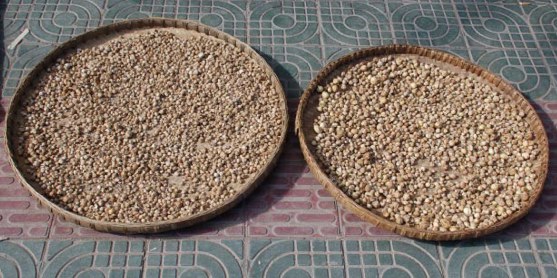 |
|
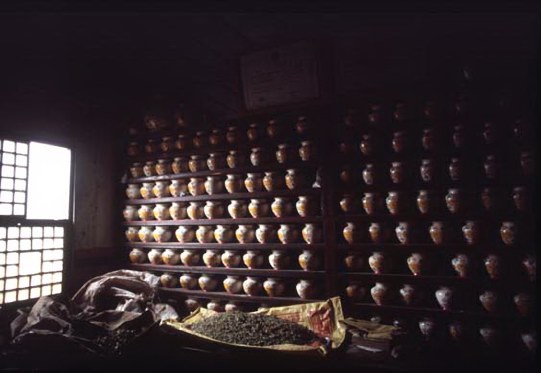 |
Medicinal plant storage room or rather the Tibetan Medicine pharmacy at Dzongsar Monastery in Derge. © Daniel Winkler, Aug. 19, 1998, Derge County, Ganzi TAP, W-Sichuan
|
|
Last update 6-19-2012
|

